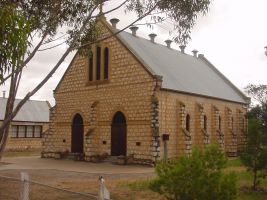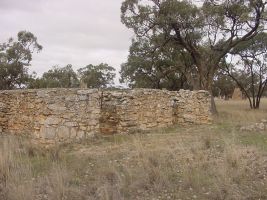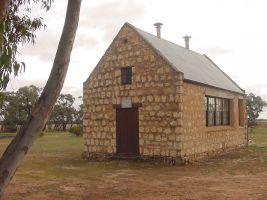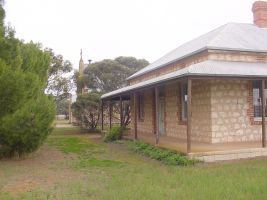![]()
| Pella |
Pella is situated 16 km west of Rainbow in the Southern Mallee region of Victorian , approximately 400 km northwest of Melbourne. It lies on Outlet Creek, a watercourse that connects Lake Hindmarsh and Lake Albacutya. There is no post office or township and Pella is not an official name. Rather it was the name given by the early Lutheran community at Outlet Creek to the place where they built their church. It draws its significance from the Pella of Palestine which appeared in Biblical times. This Pella was situated between the Sea of Galilee and the Dead Sea and was a place of refuge for Christians fleeing from the Romans during the first century A.D.
In the period 1898-1914 many families of predominantly German Lutheran origin selected virgin Mallee scrubland in the Pella region. The settlers were mostly branches of families which beforehand had already established themselves as selectors in other areas of Victoria or South Australia. They were often large families searching for more land for their sons. In some cases the old people came with their married sons or daughters, but often a recently married son came to set up his home. In its first thirty years it was a community in which there were many children, however as more areas were opened up for settlement, for example in NSW, many families moved on. The German settlers were hard working and formed a close community. Most had little money and few possessions, but they brought with them considerable farming knowledge and they built on their experience so that later generations were able to achieve obvious success.
The Lutheran Church
By 1904 it was evident that there were enough Lutherans at Outlet Creek for
them to have their own church services. Services were held at the Lutheran school
at Outlet Creek, although the congregation was still tied to Rainbow where the
church meetings were held. As there were soon more Lutherans at Outlet Creek
than in Rainbow it was decided at the church meeting on February 22nd 1909 that
these members should be released to build their own Church. It is in the minutes
of this meeting that the first record of the name Pella occurs. Earlier the
same month it had been decided to build a manse at Outlet Creek and that the
Pastor (at this time Pastor Mueller) should live there rather than at Hopetoun.
 Pella church |
 Remains of the limestone kilns |
Actual construction of the St John's Lutheran Church at Pella began in the latter half of 1910. The church was built of limestone quarried nearby and the mortar was made in kilns erected near the site. The Church, which was one of the largest Lutheran churches at that time in Victoria, was dedicated on the 14th May 1911. The order of service was printed in German and the service was conducted entirely in German. Church records up until 1918 were kept in German Sütterlin handwriting either by the Pastor or the school teacher. From 1918 until November 1920 they were kept in German Roman long-hand and after that time in English. In July 1924 the pastor, Pastor Leske, gained approval from the quarterly conference of the Pella Church for the purchase of an English Bible for the altar.
As early as 1912, the first record of an increasingly insistent request appeared in the minutes of the Pella congregation: 'Could we not have services in English now that we have a nice church?' It was finally agreed to have an English service every six weeks, as long as it did not interfere with the German services. Wartime conditions greatly increased the demand for more English services and this continued in the post war period. The pastor did not preach at Pella every Sunday and when he was not present, a reading service was held. In April 1922 it was agreed to have alternate English and German services for reading. In 1926 all German reading services were eliminated. It was not until 1932 that it was agreed to hold German and English preaching services alternately. Finally with World War II looming, it was passed that all morning services be held in English and that several afternoon services be conducted in German during the year. This was a gesture to the older generation, many of whom believed that Lutheran worship was more pleasing to God if delivered in German, however it signalled the end of an era.
The Lutheran School
Significantly plans were well in hand to start a school before the building
of a church was contemplated. In May 1902 the first classes were held in a family
home, until a school could be built. The importance of religious instruction
in the schools was highly regarded by the lay members and the clergy. For the
first half hour each morning Bible history and religion were taught in German.
Plans to build a limestone school were delayed because of severe drought at
the end of 1902 and instead an old hut was renovated. However the congregation
was still anxious to build the limestone school and work began at the end of
August 1903; the school building was opened on the 8th November the same year.
By the early 1920s changes in population meant that there were more Lutherans
living in Rainbow than at Pella and it was decided that the pastor should live
in Rainbow. The manse was then used as the residence for the school teacher.
In the 1920s and 30s the school had enrolled the maximum number of pupils permitted
by health regulations but by the 40s the numbers had dwindled and it was difficult
to attract a teacher. The school closed in 1943.
 Pella school |
 The manse |
Many descendants of the early settlers still live in the Pella area. The surnames of these families, names such as Heinrich, Drendel, Keller, Eckermann, Schilling, Keller, Stasinowsky, Krelle and Nuske, are evidence of the origins of their forefathers. Services are still conducted weekly at St John's and the manse is now used for Sunday School lessons. The church is often used for organ recitals on the fine Fuller organ which was built in Kew in 1885 and purchased by the Pella congregation in 1970. The school houses a collection of old books and photos.
In 2024 the ABC News website reported on Pella and its church organ.
Photos: Ruth Gosling, 2001
Text: Ruth Gosling, 28th February 1998.
Source: Maroske, Ian O. 1975. The Story of Pella. (© Lutheran St. John's Congregation Pella 1975; printed by Wimmera Mail-Times Pty. Ltd., Horsham)
| Top | Back
| Chronology | Issues
| Students | Site Map |
auf Deutsch |
| Primary Sources (in German) | Bibliography
| Search |
German Australia © D. Nutting 2001